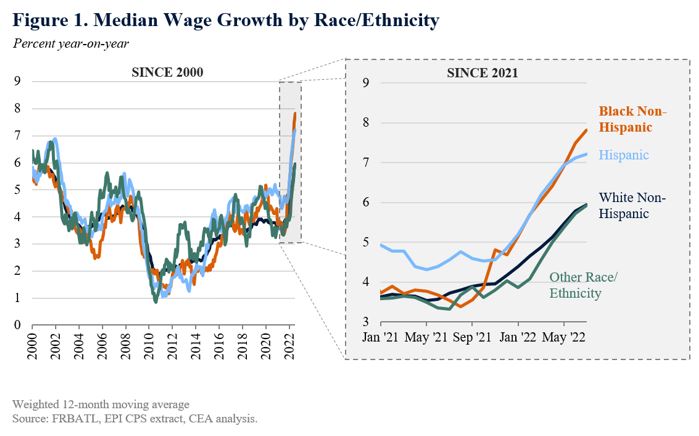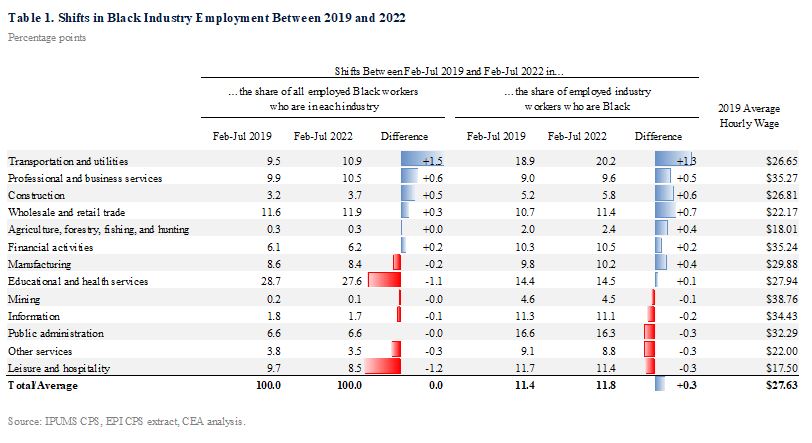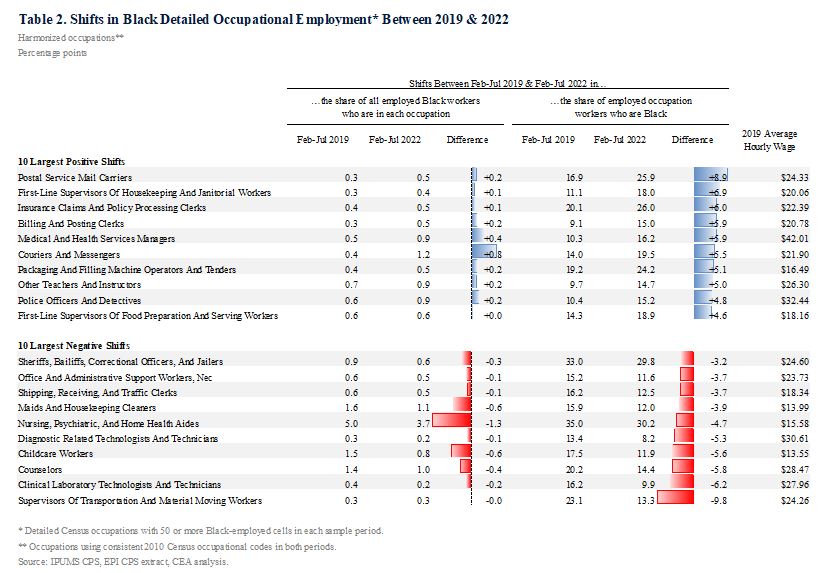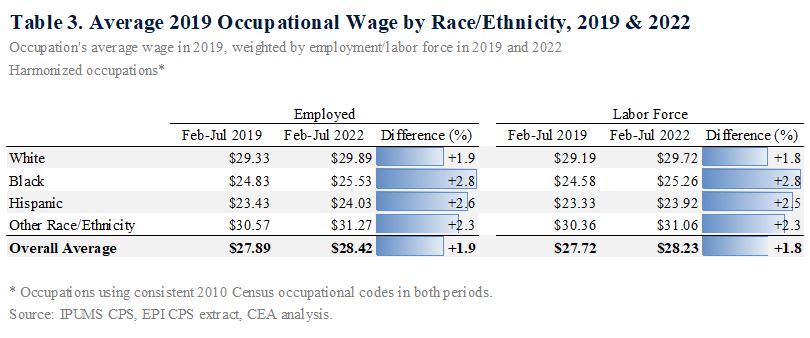Pandemic Shifts in Black Employment and Wages
The early months of the pandemic hit every American hard, but particularly Black Americans, as noted in a recent CEA issue brief. For example, the unemployment rate for Black workers peaked at 16.8 percent in May 2020, higher and later than the overall unemployment rate that peaked at 14.7 percent in April 2020.
In the months and years since early 2020, however, the U.S. labor market has seen a remarkably fast and strong recovery, and Black Americans have shared in some of these historic gains. Notably, both Black women and men have seen larger rises in employment and labor force participation since the recession’s end than the overall average, and their labor market recovery is occurring at a much faster pace than it did during the previous three business cycles in 1990, 2001, and 2007.
This blog considers two questions: first, whether there is evidence that today’s exceptionally-tight labor market has translated into similarly-exceptional wage growth for Black workers; and, second, whether there is evidence that Black workers have been moving into traditionally higher-paid sectors and jobs. The answer to both questions is “yes.” Recent median wage growth for Black workers is above the national level and has been outpacing inflation. And broadly speaking, Black workers have shifted toward higher-paying industries and occupations since before the pandemic, also at a faster pace than the national average.
Wage growth for Black workers has been relatively strong
The labor market of 2022 can be characterized by high labor demand and considerable “churn” as workers have switched jobs at elevated rates. This in turn has fueled strong wage growth, as employers pay more to recruit and retain workers. But it is difficult to get a real-time sense of how wages for Black workers in particular are faring, as few official wage measures break down the data by demographics. One that does is the Current Population Survey (CPS), a large monthly government dataset that, among other things, presents the official unemployment rate. CEA uses the detailed CPS microdata and much of the methodology employed by economists at the Federal Reserve Bank of Atlanta to produce a wage growth series for Black workers.[1]
The results in Figure 1 show that nominal median wage growth for Black workers employed 12 months apart has recently been outpacing wage growth for other groups. Over the 12 months ending in July 2022, median wage growth averaged 7.8 percent for non-Hispanic Black workers, versus 6.3 percent overall.[2]
Because inflation has also been high over this period, real (inflation-adjusted) wage growth has been much lower than the nominal unadjusted numbers. Monthly headline CPI inflation was 0 percent in July 2022, while year-on-year headline CPI inflation was 8.5 percent. The Atlanta Fed’s methodology, which was adopted for this analysis, averages year-on-year wage growth over 12 months to smooth through volatility in the CPS. Calculated the same way so that the comparison is apples-to-apples, average year-on-year headline CPI inflation over the past 12 months has been 7.4 percent. That means that, as measured by the CPS and CPI, Black workers saw modestly positive median real wage growth over this period.

Black workers have been shifting to higher-wage industries and occupations
Wages are one measure of how Black workers are progressing in the pandemic. But wage growth does not necessarily reveal whether or not Black workers have been climbing the occupational ladder. After all, wage growth has been broad across different demographic groups, industries, and jobs, so workers can see wage growth whether they switch jobs or not. To better measure whether the tight labor market has led Black workers to move into traditionally higher-wage industries and jobs, CEA looked at how two different “shares” have shifted between 2019 and today: the share of all Black workers who are in each industry or occupation, and the share of workers within each industry and occupation who are Black. These shifts are important to consider in tandem. While one of the measures can experience a positive or negative shift for idiosyncratic reasons, a positive or a negative shift in both measures together strengthens the case that Black Americans are in fact entering or leaving different types of work.
Starting with industry shifts, Table 1 shows that the Transportation and Utilities sector stands out from all the rest. Almost 11 percent of Black workers were employed in that industry on average over the past six months, a shift of +1.5 percentage points from the 9.5 percent of Black workers over the same period in 2019 (first three columns of Table 1). And while about 19 percent of Transportation and Utilities workers were Black in 2019, just over 20 percent are now, a +1.3 percentage point shift (second three columns of Table 1).
Other industries that show smaller but positive shifts in both measures are Construction, Wholesale and Retail Trade, and Professional and Business Services. The industries with the clearest and most consistent negative shifts are Leisure and Hospitality and Other Services (primarily personal care services).
There is not a consistent wage story at the major industry level. Nevertheless, it does appear in Table 1 that Black workers are, by in large, entering into higher-wage industries than the ones they are leaving. The top two positive-shift industries—Transportation & Utilities and Professional & Business Services—were on average higher-wage industries than the two biggest negative-shift industries, Other Services and Leisure & Hospitality. But there are exceptions: for example, Black workers net shifted into Agriculture—a generally low-wage industry—while shifting away slightly from Mining, a high-wage industry.

Table 2 takes the industry exercise summarized in Table 1 above and reproduces it for detailed Census occupations.[3] Table 2 shows the occupations with the 10 largest positive and negative shifts. Some notable occupations with large inflows of Black workers include: Postal Service mail carriers, insurance claim clerks, and health service managers. Occupations with noticeable declines in Black worker shares include transportation supervisors, clinical technicians, and childcare workers.
As with industries, there is not a perfectly consistent wage story with occupations, but Black workers during the pandemic appear to have entered into jobs that are traditionally higher-wage than the ones they have left behind. Table 3 confirms this by showing what wages in 2019 and 2022 by race/ethnicity would be if each occupation were held at its average 2019 wage. A rise in wages by this measure would signal that a group was net advancing to higher-paying jobs on average. Looked at this way, Black Americans have seen more “occupational upgrade” during the pandemic than the country as a whole. Back in 2019, the average employed Black worker was in an occupation that paid $24.83 an hour. Today, the average Black worker is in a job that would have paid $25.53 an hour in 2019, a +2.8 percent rise. That shift is larger than the +1.9 percent increase among all Americans. The results are similar when looking at all workers in the labor force (whether they have or are actively looking for a job) rather than just employed workers.


Conclusion
Black Americans continue to face challenges in the pandemic labor market as they did prior to the pandemic, but there are signs of genuine progress. CEA’s analysis using the CPS shows that recent wage growth for Black workers is stronger than that of the workforce as a whole—and slightly outpacing inflation. Additionally, Black Americans have gained some ground moving up the ladder to traditionally higher-paying industries and occupations. A central goal of the Biden Administration’s economic strategy is generating sustainable growth that is equitably shared. That means continuing to address both short- and long-run challenges to communities of color while also working to retain the progress that has been made.
METHODOLOGICAL APPENDIX
Median wage growth in the CPS
CEA measures median hourly wage growth in the CPS in a similar vein to the Federal Reserve Bank of Atlanta’s Wage Growth Tracker (WGT). The WGT does not publish wage growth statistics for Black workers, only for “non-white” and “white” workers. CEA uses the CPS Outgoing Rotation Group (ORG) extract published by the Economic Policy Institute (EPI), which uses a transparent and consistent methodology for calculating hourly wages among workers in CPS who only report their earnings on a weekly basis. “Median wage growth” as defined by the WGT and by CEA in this analysis is the median of hourly wage growth among workers longitudinally-linked across 12 months in the CPS and employed with valid wage data at both points. Similar to the WGT, CEA excludes wages whose values are imputed or top-coded, wages above $100/hour or below $2.13/hour (the tipped minimum wage), and wages earned by farm workers. CEA weights median wage growth in this analysis by a longitudinal weight raked to ensure that successful record matches reflect the actual population along race, ethnicity, sex, age, labor force status, and major industry and occupation among the employed.
[1] See details in the Methodological Appendix.
[2] As with the Atlanta Fed Wage Growth Tracker (WGT), these numbers are 12-month moving averages of year-on-year wage growth.
[3] Table 2 only includes detailed occupations for which there are at least 50 Black-employed cells in each of the two sample periods in the CPS.

